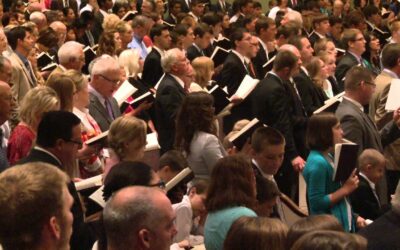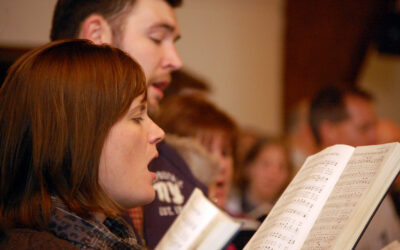Everything we do in life requires some amount of preparation. Before we go to work in the morning we have a time of preparation that probably includes bathing, brushing your teeth, eating breakfast (not necessarily in that order). If we’re hosting Thanksgiving at our house there will probably be a little bit of preparation. It’s unlikely you would wake up Thanksgiving morning, watch the Macy’s Thanksgiving Day Parade, and then think, “hmmm, I wonder what we’re going to eat for lunch.” Before He began his earthly ministry Jesus spent 40 days in the wilderness preparing Himself for that work.
When we begin to think about corporate worship we realize it is the most important activity in which a local body of Christ participates on a weekly basis. And, just like everything else in our life, worship requires preparation. The pastor must prepare the sermon and the musicians must practice their music. We, personally, must prepare ourselves individually throughout the week before we come to church to worship corporately. Just like everything else we do, worship requires preparation, and when we gather together corporately we need to prepare corporately.
Our world and our lives are busy and chaotic. We engage in so many activates we don’t know how we can accomplish all of them. We have responsibilities. We participate in things that bring us joy or fulfillment. All of these life activities I call “secular time.” They are a huge chunk of our week and each activity requires preparation. I call corporate worship “sacred time” for it is a brief period we set aside to gather together as a family of believers and offer our praise to God and to hear Him instruct us. Sacred time, that time of corporate worship, is a very special time and very different from our secular time. We need a time of corporate preparation to enter into the worship of God.
The prelude, when used properly, functions as space between the busy secular time and the corporate sacred time. The prelude helps put a buffer between those two very different, divergent time periods. The prelude, when used appropriately, can be designed to help mitigate the distractions of secular time, the concerns about family obligations, finances, health, etc., and, at the same time, sharpen the focus of the congregation to get their minds and hearts ready for corporate worship. The prelude is a buffer between secular time and sacred time.
When I was a child the church my family attended placed a notice in the bulletin, listed right below the title of the prelude, that said, “The prelude is a veil dropped between everyday life and the sanctuary.” This was a theologically significant statement to make. It taught me from a young age the function of the prelude. The prelude wasn’t simply something you did before worship but rather was something that had a purpose.
The prelude, however, is NOT a part of worship. It is the PREPARATION for worship. It is the buffer between secular time and sacred time—the time of corporate worship. It is not necessary to label the prelude as “the prelude” if the term makes you uncomfortable. You could identify it by its function—”The Preparation for Worship” or some other descriptive term or phrase. It’s not important what you call it but that you have it. That you use it as a brief time of preparation to help the congregation focus away from all that would distract them and instead focus solely on God.
In the best practices of traditional worship the prelude will be focused time. It will be a brief period set aside, not background music. Many congregations treat the prelude as “wallpaper music” performed as the congregation gathers in the worship space chatting with their neighbors and welcoming guests. This use of pre-service music is not what I’m advocating. If you like the idea of music going while the congregation gathers call it “gathering music” instead of “prelude.” Gathering music is simply there in the background to set the mood of the worship space. The best practices of traditional worship, though, will include the prelude as a specific focused time where there is no other activity.
If the idea of the prelude (as described here) is new to your congregation you’ll need to have a “break in” period to teach them the what, why, and how of the prelude. Before the first Sunday worship you’ll need to teach the congregation what the prelude is for, why it is important to corporately prepare for worship, and what their behavior and affect should be during the prelude. A verbal word of instruction before the prelude for several weeks in a row, maybe up to a month or two, reminding the congregation what, why, and how will give them the chance to engage in the prelude as preparation for worship. All this instruction is to normalize the new use of the prelude so it becomes a part of their routine. They’ll learn when the prelude begins they are to prepare for worship. Once the pattern is set then a simple statement in the bulletin or on the screens to remind them of the function of the prelude will be sufficient.
Once the pattern of using the prelude as preparation has been established you’ll be able to expand the breadth of the prelude. One excellent way to help the congregation focus on preparation is to simply put a focus sentence, a one or two sentence synopsis of what the theme of worship is for that particular day. Another option to consider would be placing a written prayer and instruct the congregation to use it as their personal preparation for worship. If the prelude music is a hymn tune that the congregation knows include the text of that hymn so that they can focus on the text.
Not all performers are appropriate for the prelude. Some modes of musical expression by nature draw attention to themselves. Vocal soloists for instance or the children’s choir demand personal attention and thus defeat the purpose of the prelude. In my experience instrumental music (piano, guitar, organ, instrumental ensembles) is more appropriate and beneficial for the function of the prelude. In the best practices of traditional worship the prelude will be something the congregation will see THROUGH, it will point them to the object of our worship rather than to the music itself. These performers tend be easier to “see through” to the object of worship than vocal soloists or vocal ensembles. This does NOT mean that vocal soloists or vocal ensembles are inappropriate in OTHER parts of worship. They simply don’t work well as the prelude.
Likewise not all music is appropriate for the prelude. In general, the prelude should not be something that draws UNDUE attention to itself. The music selected should avoid musical gimmicks or excessive attention-grabbing technical demands. Both features draw attention to the music rather than to God thus defeating the purpose of the prelude. This does not mean that the music selected must be only subdued and introspective. Quite to the contrary, some of the most effective preludes are majestic and powerful. It just means that the music doesn’t become an end in itself. The best way for the prelude to be effective is to ensure the music fits or amplifies the theme of worship for that day. The prelude, when used appropriately, can highlight a hymn that will be used in the worship service, or the theme of the worship service, or the focal point of the sermon, or the focal point of the scripture passages used in the worship service. The prelude needs to fit and to be most effective it needs to fit in a fairly obvious way.
The prelude is a funnel through which the congregation gathers together and corporately prepares for the worship of God. The prelude, then is utilitarian.
_______________
Sacred Song Consulting exists solely to help congregations refine, revitalize, and reform traditional worship for contemporary people. We are a resource for all worship leaders. We are a guide to lead you to the best practices of traditional worship. We provide you with the tools to plan, prepare, and lead traditional worship, the nuts-and-bolts concepts that help traditional worship honor God and enrich the congregation. We are here to help you! You are not alone in your desire to have transformative worship in your congregation. Reach out to us. Let us know how we can help you!



Thanks for your blog, nice to read. Do not stop.
More to come!
I love the idea of the veil. We don’t have a prelude now but maybe we will in the future. It does hive time to shift gears.
Using the prelude as described will give the congregation the time to focus on the worship that is about to take place. When a congregation understands the pre-worship/preparation for worship function of the prelude they’ll embrace it and expect it!